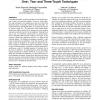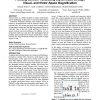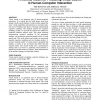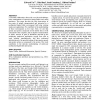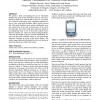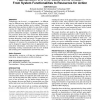CHI
2007
ACM
14 years 12 months ago
2007
ACM
We investigate pointing at graphical targets of arbitrary shapes. We first describe a previously proposed probabilistic Fitts' law model [7] which, unlike previous models tha...
CHI
2007
ACM
14 years 12 months ago
2007
ACM
On traditional tables, people frequently use the third dimension to pile, sort and store objects. However, while effective and informative for organization, this use of the third ...
CHI
2007
ACM
14 years 12 months ago
2007
ACM
We present an observational study that was conducted to guide the design and development of technologies to support information flow during nurses' shift change in a hospital...
CHI
2007
ACM
14 years 12 months ago
2007
ACM
Using a stylus on a tablet computer to acquire small targets can be challenging. In this paper we present pointing lenses ? interaction techniques that help users acquire and sele...
CHI
2007
ACM
14 years 12 months ago
2007
ACM
Visual search is an important part of human-computer interaction. It is critical that we build theory about how people visually search displays in order to better support the user...
CHI
2007
ACM
14 years 12 months ago
2007
ACM
Co-located collaborators often work over physical tabletops using combinations of expressive hand gestures and verbal utterances. This paper provides the first observations of how...
CHI
2007
ACM
14 years 12 months ago
2007
ACM
Phishing attacks, in which criminals lure Internet users to websites that impersonate legitimate sites, are occurring with increasing frequency and are causing considerable harm t...
CHI
2007
ACM
14 years 12 months ago
2007
ACM
We present a study investigating the use of vibrotactile feedback for touch-screen keyboards on PDAs. Such keyboards are hard to use when mobile as keys are very small. We conduct...
CHI
2007
ACM
14 years 12 months ago
2007
ACM
Information shown on a tabletop display can appear distorted when viewed by a seated user. Even worse, the impact of this distortion is different depending on the location of the ...
CHI
2007
ACM
14 years 12 months ago
2007
ACM
Technologies can be used ? or appropriated ? in different ways by different users, but how do the use patterns evolve, and how can design facilitate such evolution? This paper app...

